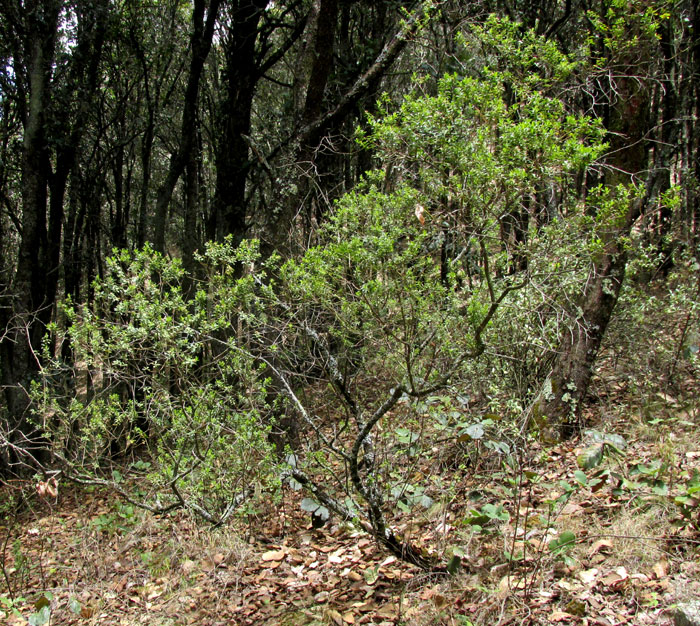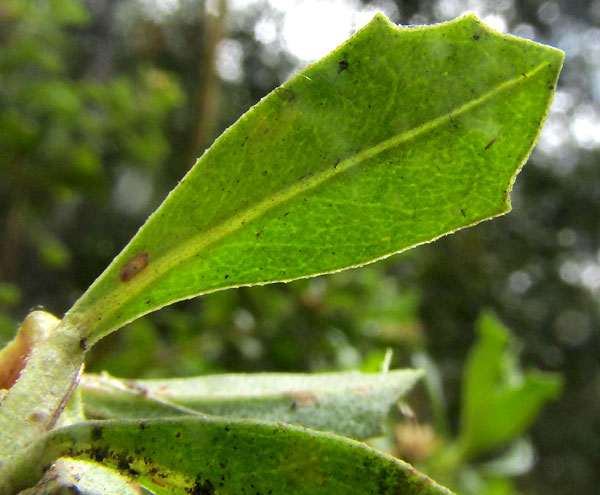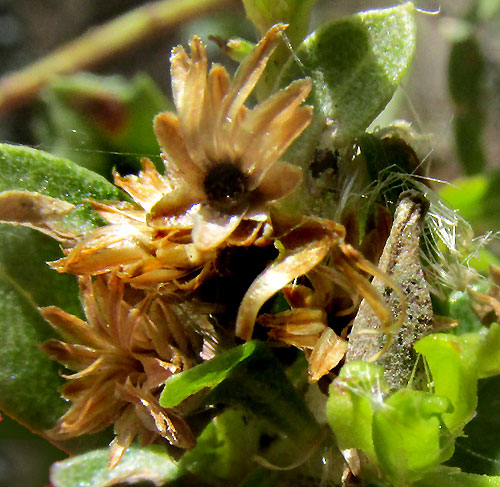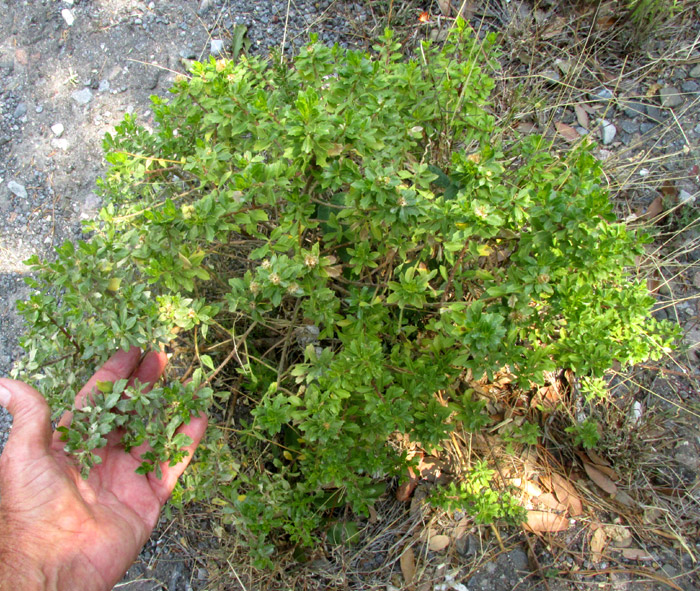Excerpts from Jim Conrad's
Naturalist Newsletter
entry from field notes dated July 1, 2022, on Cerro de la Cruz, at elevation ~2885m (~9465 ft), on the south side of the community of El Pinar, Amealco de Bonfil, Querétaro, MÉXICO, (~N20.17°, ~W100.17°)
A HANDSOME BACCHARIS

In an open area in the oak woods of a valley opening toward the east, the above small tree was like a big bonsai pruned and trained to look artful, but this tree was just being itself. Wanting to know what it was, I looked at the leaves:

The somewhat leathery leaves were shiny as if shellacked, and dust, pollen and such seemed to stick to them. Looking closely at one, glands probably responsible for producing sticky resin could barely be see among the reticulating network of veins, though usually on leaves of such sticky plants they're obvious:

What is indeed obvious with the above leaf is its unusual form, the very few teeth on the margins, and the blade being broadest above its middle, gradually narrowing toward its connection with the stem, with no typical petiole. In the eastern US there's a bush with leaves similarly toothed and shaped, the Eastern Baccharis, Baccharis halimifolia. Eastern Baccharis is among that small percentage of Composite or Aster Family members that are woody. Could this be a species of Baccharis?

The above was found at the tip of one branch. The star-like, tan-colored things are last season's involucres, the part that in Aster Family flowering heads is like a green, scaly cup below the cluster of florets. In the picture, the white-parachuted, one-seeded, cypsela-type fruits already have been disseminated by the wind, but some white hairs, parts of a cypsela parachute, remain, maybe stuck to the leaves' resiny surface. The white item on the picture's right looks like the bottom side of an upside-down, detached leaf covered with white flecks of dried resin.
Despite lacking flowers or fruits, the above noted features were enough to identify this, with the help of the Flora de Veracruz, as BACCHARIS CONFERTA, another species collected and introduced to science by Humboldt and Bonpland when they passed through our area in 1804. The species is endemic to central Mexico from San Luis Potosí state south to Oaxaca, occupying many habitats from fir, pine and oak-pine forests to riverbanks and weedy disturbed areas. No English name is associated with it but in Spanish it's often known by various names meaning "broom," such as Escobo, Escobilla and Escobilla China. The conferta in our plant's binomial means "crammed together," maybe referring to how the flowers and their remnants are so packed together on branches, not diffusely arranged as with many baccharis species.
Baccharis species mostly produce male or female trees; they're "dioecious." It was just luck that we had a female tree still bearing old involucres.
Often resinous or glandular plants are medicinal, and that's the case with Baccharis conferta. The online Guía Ilustrada de Plantas Medicinales en el Valle de México reports that an infusion of its stems and leaves swished around in the mouth helps with toothache. The infusion can also be used to clean a mother after giving birth. The stems can be chewed to treat indigestion, diarrhea and colic. In fact, the Náhuatl name for the plant is Necheloli, literally meaning "to collect bile," probably relating to the cure for diarrhea and colic. The 2015 study by Edison Camilo Monroy Fuquen and Verónica Ramos Martínez entitled "Analisis Fitoquimico y Evaluacion de la Actividad Antimicrobiana y Antioxidante de la Especie Vegetal 'Baccharis latifolia'" found that our Baccharis conferta demonstrated a mild antibacterial activity against the bacterium Escherichia coli, the usual bacterial culprit causing diarrhea.
In the online Master's thesis of María Magdalena López Méndez, entitled "Especies Nativas Potencialmente Apícolas para Cercas Vivas y Áboles en Linderos Como Alternativa de Floración Escalonada," I read that in riparian areas (beside rivers and streams) Baccharis conferta attracted the greatest numbers of pollinators, and was one of the most important of all species for pollinators in her study area.
It's common practice on many of Mexico's high-elevation slopes to "clear away" all vegetation to make way for plantations of fir trees, Abies religiosa. A 2011 study by Lázaro Rafael Sánchez-Velásquez and others, entitled "Does Baccharis conferta Shrub Act as a Nurse Plant to the Abies religiosa Seedling," concluded that when fir and our baccharis are interplanted "... B. conferta promotes the seedling growth of A. religiosa, reducing costs for commercial plantations or plantations aimed towards restoration."
entry from field notes dated May 5, 2023, taken along paved road to El Doctor, about 2km above intersection with Hwy 120 running east to San Joaquín; juniper, oak and pine forest on limestone bedrock; elevation ±2500m (8200 ft); Eastern Sierra Madre mountains of east-central Querétaro state, MÉXICO, (N20.88°, W99.62°)
BACCHARIS, DIFFERENT LOOK

Seeing the above compact, roundish, hardly knee-high bush, it didn't occur to me that it could be the same baccharis species documented atop this page, but then I saw the leaves:

The leaves are a perfect match. This time the leaf pictured shows the typical mottling seen on the species' leaves. The literature often refers to glutinous, or sticky, leaves, or sometimes resinous ones, though I've not found anything sticky or resinous about them; maybe I would in hotter weather. I'm guessing that the mottling observed above results from glands embedded in the leaf tissue -- as in citrus leaves -- containing certain oils and compounds. Maybe these can cause the stickiness, and also they might account for the bush's fame in traditional Mexican medicine.

This time I get a clearer notion of the species' flower arrangements, especially regarding the matter that the Flora of North America and other authorities describe the genus Baccharis as consisting of plants that are dioecious (separate male and female plants), or rarely monoecious (unisexual male and female flowers on same plant). Technical descriptions I've found don't make clear what the case is with Baccharis conferta.
Whatever the situation, above the image shows both unisexual male and unisexual female flowers on the same plant. Above we see a single compact inflorescence consisting of three composite flowering heads. In the top flowering head we see several unisexual male florets with yellow, granular pollen dusting their anthers' tops, so we know that they're ready to pollinate. Notice that these male florets' tubular corollas display five clearly visible lobes that curl outward and downward. In the bottom flowering heads, unisexual female florets are strikingly different from the males'. Their corollas are much slenderer, with lobes reduced to five minuscule teeth at their tops. Moreover, interspersed among them, at least in the flowering head at the lower, left, appear to be older male flowers -- or flowers with both sexual parts? -- with relatively larger corolla lobes withering and turning brown, and no signs of anthers.
Viewing other photos on the Internet, I gain the general impression that the first baccharis seen, atop this page, was an old one in the fairly rich soil of a somewhat shaded area, in contrast to this latter one, which may be younger, in a very exposed location in poor soil at the very edge of a highway.